 W
WThe Academy of General Dentistry (AGD) is a professional association of general dentists from Canada and the United States.
 W
WAmosan is an oral antiseptic rinse. In 2014, Vintage Brands Limited began manufacturing and selling an oral antiseptic rinse containing 68.635% (w/w) Sodium Perborate under the Amosan brand name. Until 2010, Amosan was an oral wound cleanser manufactured in Belgium and sold under the Oral-B brand, belonging to Procter & Gamble after its recent acquisition of Gillette (2005). It is used to aid in the prevention of, as well as speed the recovery from canker sores, denture irritation, orthodontic irritation, and oral injuries or after dental procedures. It is distributed in a powdered form that requires reconstitution with warm water, after which it is used as a mouth rinse. It is customarily packaged in 1.7g envelopes.
 W
WIn anatomy the apical foramen is the opening at the apex of the root of a tooth, through which the nerve and blood vessels that supply the dental pulp pass. Thus it represents the junction of the pulp and the periodontal tissue.
 W
WBocasan was an oral wound cleanser manufactured in the United Kingdom by Knox Laboratories Ltd of London from 1960–1975, before being rebranded as an Oral-B product
 W
WTruman William Brophy was an American oral surgeon. He's known to be the founder of the Chicago College of Dental Surgery. He also served as the American President of the Fourteenth International Medical Congress in Madrid in 1903. He was known to create innovative techniques to correct cleft lip and cleft palate.
 W
WMargaret Caro was a New Zealand dentist, social reformer, lecturer and writer. In 1881 she was the first woman to be listed on the Dentists' Register of New Zealand.
 W
WThe cementoenamel junction, frequently abbreviated as the CEJ, is a slightly visible anatomical border identified on a tooth. It is the location where the enamel, which covers the anatomical crown of a tooth, and the cementum, which covers the anatomical root of a tooth, meet. Informally it is known as the neck of the tooth. The border created by these two dental tissues has much significance as it is usually the location where the gingiva attaches to a healthy tooth by fibers called the gingival fibers.
 W
WThe cervical margin of a tooth is the surface above the junction of the crown of the tooth and the root of the tooth.
 W
WCoupland’s elevators are instruments commonly used for dental extraction. They are used in sets of three each of increasing size and are used to split multi-rooted teeth and are inserted between the bone and tooth roots and rotated to elevate them out of the sockets. The instruments were designed by Doctor Douglas C W Coupland who qualified as a Dental Surgeon in Toronto in 1922 and spent most of his career practising dentistry in Ottawa where he specialised in dental extraction. Coupland designed the instruments in the 1920s; they were manufactured by the Hu-Friedy company and sold from the early 1930s initially as sets of eight or twelve which were later reduced to three. Coupland also designed a set of dental suckers with interchangeable tips. He died in 1936 after only 13 years of clinical practice.
 W
WIn dentistry, crown refers to the anatomical area of teeth, usually covered by enamel. The crown is usually visible in the mouth after developing below the gingiva and then erupting into place. If part of the tooth gets chipped or broken, a dentist can apply an artificial crown. Crowns are used most commonly to entirely cover a damaged tooth or cover an implant. Bridges are also used to cover a space if one or more teeth is missing. They are cemented to natural teeth or implants surrounding the space where the tooth once stood. There are various materials that can be used including a type of cement or stainless steel. The cement crowns look like regular teeth while the stainless steel crowns are silver or gold.
 W
WIn anatomy, the Curve of Spee is defined as the curvature of the mandibular occlusal plane beginning at the premolar and following the buccal cusps of the posterior teeth, continuing to the terminal molar. According to another definition the curve of Spee is an anatomic curvature of the occlusal alignment of the teeth, beginning at the tip of the lower incisor, following the buccal cusps of the natural premolars and molars and continuing to the anterior border of the ramus. It is named for the German embryologist Ferdinand Graf von Spee (1855–1937), who was first to describe the anatomic relations of human teeth in the sagittal plane.
 W
WThe dental arches are the two arches of teeth, one on each jaw, that together constitute the dentition. In humans and many other species; the superior dental arch is a little larger than the inferior arch, so that in the normal condition the teeth in the maxilla slightly overlap those of the mandible both in front and at the sides. The way that the jaws, and thus the dental arches, approach each other when the mouth closes, which is called the occlusion, determines the occlusal relationship of opposing teeth, and it is subject to malocclusion if facial or dental development was imperfect.
 W
WThe dental midline is the midsagittal line of maxillary and mandibular dental arches possessing teeth of ideal size, shape, and position, when situated in maximum intercuspation. Each arch also possesses its own midline, which can be used to refer to the location of contact between the mesial surfaces of the central incisors. Thus, if an individual's mandibular teeth are shifted over to the left in a mesial-distal dimension, by 2 mm, for example, that individual's midline would be said to be deviated 2 mm to the left.
 W
WIn dentistry, diagnostic wax-up is used to visualize the results of a prosthetic case prior to the treatment being executed.
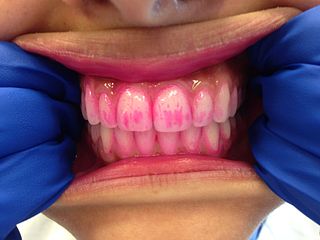 W
WDisclosing tablets are chewable tablets used to make dental plaque visible.
 W
WEastmaninstitutet is a dental care centre specialized in orthodontics, periodontology and oral surgery located in Vasastaden, Stockholm, Sweden. It was built by a million dollar donation from the American inventor George Eastman and opened in 1937.
 W
WAn electronic apex locator is an electronic device used in endodontics determine the position of the apical constriction and thus determine the length of the root canal space. The apex of the root has a specific resistance to electrical current, and this is measured using a pair of electrodes typically hooked into the lip and attached to an endodontic file.
 W
WElmex is a brand of toothpaste that has been sold since 1962. It is manufactured by GABA International AG, a Swiss manufacturer of branded oral care products located in Therwil. GABA is wholly owned by Colgate-Palmolive company of the United States. Elmex was the first toothpaste to contain the organic Amine Fluoride (AmF) olaflur as an active ingredient for protection against dental caries. Elmex is often sold together with Aronal which should be used in the morning. Aronal contains vitamin A and zinc to protect the gums against inflammation.
 W
WIn dentistry, embrasures are V-shaped valleys between adjacent teeth. They provide a spill way for food to escape during chewing which essentially aids in the self-cleansing process. They also prevent food from being forced through the contact area which might cause food packing and periodontal pain and permit a slight amount of stimulation to the gingiva.
 W
WA face-bow is a dental instrument used in the field of prosthodontics. Its purpose is to transfer functional and aesthetic components from patient's mouth to the dental articulator. Specifically, it transfers the relationship of maxillary arch and temporomandibular joint to the casts. It records the upper model's (maxilla) relationship to the External Acoustic Meatus, in the hinge axis. It aids in mounting maxillary cast on the articulator.
 W
WA facemask is a type of an orthodontic headgear used to treat underbite and other malocclusions where the upper jaw is too far backwards. A metal bar sits in front of the patients face with support from the forehead and chin. Elastics are connected to the metal bar and the teeth - directly through the lips / mouth of the patient. The elastics apply forward and downward pressure on the upper jaw. Thus the force direction is the opposite from a standard headgear which is why this appliance is also known as a reverse-pull-headgear.
 W
WThe free gingival margin is the interface between the sulcular epithelium and the epithelium of the oral cavity. This interface exists at the most coronal point of the gingiva, otherwise known as the crest of the marginal gingiva.
 W
WThe Glasgow Dental Hospital and School is a dental teaching hospital, situated in the Garnethill area of the city centre of Glasgow, Scotland.
 W
WGouania lupuloides, known as chewstick or whiteroot, is a neotropical plant of the family Rhamnaceae. It is occasionally used as a teeth cleaning implement.
 W
WThe inner enamel epithelium, also known as the internal enamel epithelium, is a layer of columnar cells located on the rim nearest the dental papilla of the enamel organ in a developing tooth. This layer is first seen during the cap stage, in which these inner enamel epithelium cells are pre-ameloblast cells. These will differentiate into Ameloblasts which are responsible for secretion of enamel during tooth development.
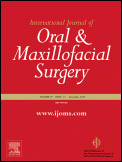 W
WThe International Journal of Oral and Maxillofacial Surgery is a peer-reviewed medical journal covering oral and maxillofacial surgery, oral pathology, and related topics. It is published monthly by Elsevier for the International Association of Oral and Maxillofacial Surgeons.
 W
WThe Kansas Dental Board (KDB) is the state agency regulating dentistry. Its headquarters are in Room 564-S in the Landon State Office Building in Topeka.
 W
WThe Lewis offset is a term for the portion of the central groove on a permanent mandibular first molar which lies between the two central pits. It was named for long time dental anatomy instructor Dr. Christopher S. Lewis, a Mercer Island, WA dentist.
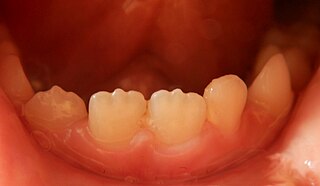 W
WA mamelon is one of three rounded protuberances which are present on the cutting edge of an incisor tooth when it first erupts through the gum. Mamelons appearance can be smoothed by a dentist if they haven't been worn down naturally by biting and eating foods. Mamelons are present on permanent central and lateral incisors. Mamelons are easiest to observe on the maxillary central incisors, and appear as three small prominences on the incisal edge of the tooth. Mamelons are ordinarily of no clinical importance. Usually they are worn off early in the life of the tooth. However, when an anterior open bite is present—that is, the anterior teeth are not in contact when the bite is fully closed—mamelons may remain into adulthood.
 W
WThe mandibular first premolar is the tooth located laterally from both the mandibular canines of the mouth but mesial from both mandibular second premolars. The function of this premolar is similar to that of canines in regard to tearing being the principal action during mastication, commonly known as chewing. Mandibular first premolars have two cusps. The one large and sharp is located on the buccal side of the tooth. Since the lingual cusp is small and nonfunctional, the mandibular first premolar resembles a small canine. There are no deciduous (baby) mandibular premolars. Instead, the teeth that precede the permanent mandibular premolars are the deciduous mandibular molars.
 W
WThe maxillary first premolar is one of two teeth located in the upper jaw, laterally from both the maxillary canines of the mouth but mesial from both maxillary second premolars. The function of this premolar is similar to that of canines in regard to tearing being the principal action during mastication, commonly known as chewing. There are two cusps on maxillary first premolars, and the buccal cusp is sharp enough to resemble the prehensile teeth found in carnivorous animals. There are no deciduous maxillary premolars. Around 10-11 years of age, the primary molars are shed and the permanent premolars erupt in their place. It takes about 3 years for the adult premolar and its root to fully calcify.
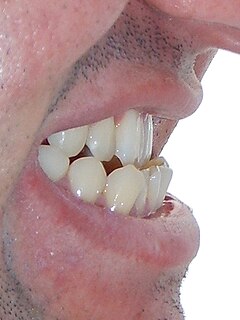 W
WMaxillary hypoplasia, or maxillary deficiency, is an underdevelopment of the bones of the upper jaw. It is associated with Crouzon syndrome, Angelman syndrome, as well as fetal alcohol syndrome. It can also be associated with cleft lip and cleft palate. Some people could develop it due to poor dental extractions.
 W
WIn dentistry, maximum intercuspation refers to the occlusal position of the mandible in which the cusps of the teeth of both arches fully interpose themselves with the cusps of the teeth of the opposing arch. This position used to be referred to as centric occlusion.
 W
WMentadent is a brand name for a line of dental products manufactured by Unilever for its home and international markets excluding the United States and Canada where the company sold its rights to the brand to Church & Dwight Company in 2003.
 W
WDr Melvin L. Moss was an American dentist known for creating the functional matrix hypothesis for growth and development. He was an anatomist and former dean of Columbia University College of Dental Medicine.
 W
WThe Myanmar Dental Association is a professional association established in 1979 which has more than 4,000 members. The association publishes Myanmar Dental Journal every year. It also arranges Myanmar Dental Conference in which FDI World Dental Federation speakers also make their presentations. Myanmar Dental Association and Myanmar Dental Council are the only two professional organizations for Myanmar Dentists.
 W
WThe Myanmar Dental Council is a professional association established in 1970 which has more than 4,000 members. The Myanmar Dental Council is formed under the Myanmar Dental Council law with the approval of the Ministry of Health of Myanmar.
 W
WNon-carious cervical lesions (NCCLs) are defined as dental tissue lost at or near the cementoenamel junction (CEJ), and not relating to tooth decay. NCCLs are common in the dentitions of recent human populations. They may result from several processes including abrasion, acid erosion and abfraction. It is thought recent changes in diet and behaviour may explain the high rate of NCCLs in humans today, including consuming a lot of acidic foods and drinks, as well as tooth brushing techniques. Periodontal disease is often also a contributing factor.
 W
WAn open contact is a term used in dentistry to describe the space between adjacent teeth when the teeth are neither touching nor a sufficient distance from each other to potentially allow the space to naturally remain free of debris.
 W
WAn oral torus is a lesion made of compact bone and occurs along the palate or the mandible inside the mouth. The palatal torus or torus palatinus occurs along the palate, close to the midline, whereas the mandibular torus or torus mandibularis occur along the lingual side of the mandible.
 W
WThe outer enamel epithelium, also known as the external enamel epithelium, is a layer of cuboidal cells located on the periphery of the enamel organ in a developing tooth. This layer is first seen during the bell stage.
 W
WPlane-form enamel hypoplasia is often seen as the most severe type of enamel hypoplasia, and results from enamel matrix formation stopping, resulting in areas of crown with little or no dental enamel deposition. A relatively short period of severe stress can potentially lead to a very large defect. Plane-form enamel hypoplasia can be caused by a variety of factors, including severe illness/malnutrition, as well as specific conditions such as amelogenesis imperfecta and congenital syphilis. In severe cases enamel can be completely missing from areas of the crown, exposing the underlying dentine.
 W
WIn restorative dentistry, precision attachments are the functional mechanical parts of the removable partial denture made of plastic, metal or a combination of both. They consist of two parts referred as the 'male' part that is fixed to a crown inside the patient's mouth and a 'female' part which holds the partial denture.
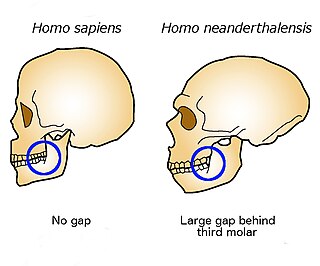 W
WThe retromolar space or retromolar gap is a space at the rear of the mandible, between the back of the last molar and the anterior edge of the ascending ramus where it crosses the alveolar margin.
 W
WThe stellate reticulum is a group of cells located in the center of the enamel organ of a developing tooth. These cells are star-shaped and synthesize glycosaminoglycans. As glycosaminoglycans are produced, water is drawn in between the cells, stretching them apart. As they are moved further away from one another, the stellate reticular cells maintain contact with one another through desmosomes, resulting in their unique appearance. The stellate reticulum is lost after the first layer of enamel is laid down. This brings cells in the inner enamel epithelium closer to blood vessels at the periphery.
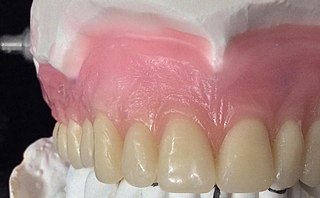 W
WThe gingiva often possess a textured surface that is referred to as being stippled. Stippling only presents on the attached gingiva bound to underlying alveolar bone, not the freely moveable alveolar mucosa. Stippling used to be thought to indicate health, but it has since been shown that smooth gingiva is not an indication of disease, unless it is smooth due to a loss of previously existing stippling.
 W
WThe striae of Retzius are incremental growth lines or bands seen in tooth enamel. They represent the incremental pattern of enamel, the successive apposition of different layers of enamel during crown formation.
 W
WThe sulcular epithelium is that epithelium which lines the gingival sulcus. It is apically bounded by the junctional epithelium and meets the epithelium of the oral cavity at the height of the free gingival margin. The sulcular epithelium is nonkeratinized.
 W
WThe Texas State Board of Dental Examiners (SBDE) is a state agency of Texas. It has its headquarters in Suite 800 of Tower 3 of the William P. Hobby State Office Building in Downtown Austin, Texas. The board regulates dental clinics in the state. The agency includes an executive division with five employees, an administration, finance, and personnel division with two employees, a licensing division with six employees, an enforcement division with fourteen employees, and a legal division with seven employees. The dental board itself has 15 board members.
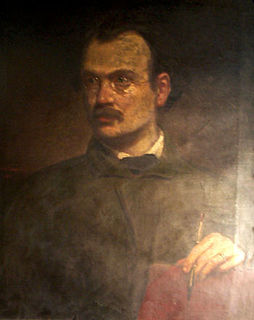 W
WAdalbert J. Volck (1828–1912) was a dentist, political cartoonist, and caricaturist born in Bavaria. He was best known for his support of the Confederacy during the American Civil War, through his political cartoons (below), smuggling items for the Confederate army, and personally assisting President Jefferson Davis by acting as a courier. Volck lived in Baltimore and was a member of the Charcoal Club of Baltimore for whom he created a "ceremonial growler, or beer pitcher."
 W
WWax rims are devices that are used in dentistry to help in the fabrication of removable prostheses, such as complete and partial dentures.
 W
WJames Leon Williams was an American prosthodontist and a pioneer dental histologist. He discovered the significance dental plaque.